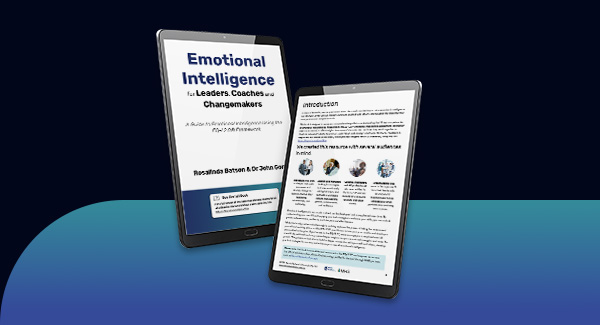Flexibility and Emotional Intelligence: The Art of Adapting with Insight

Flexibility and Emotional Intelligence
Flexibility is the ability to adjust your emotions, thoughts and behaviour to changing situations and conditions. It's about being adaptable and rolling with the punches, rather than getting stuck in a rigid approach.
The flexibility component of emotional intelligence concerns our overall ability to adapt to unfamiliar, unpredictable and fluid circumstances. Flexible people are able to change their minds when evidence suggests they are mistaken. Changing your mind, or adjusting your approach, is not weak or a sign of lack of competence. It’s a sign of courage, it says ‘I thought I was right, but perhaps there are other options, and I’m a big enough person to be able to adjust’.
In today’s business environment, flexibility is more important than ever for success because it allows you to take advantage of new information as it arises, adapt to change as it occurs and respond to shifts in priorities. Flexibility is a key component of emotional intelligence because it fosters resilience and helps you navigate the complexities of life.
Flexibility in Action
Let’s delve deeper into how flexibility manifests in real-world scenarios and its impact on emotional intelligence (EQ).
People with high Flexibility exhibit these behaviours:
Adapting to Change:
Flexible people can readily adjust to new situations, unexpected challenges, or shifting priorities. Flexibility empowers them to adapt their thoughts and behaviours based on shifting feedback they receive from their environment.
- Scenario: A global pandemic disrupts the company's supply chain. A leader with high Flexibility quickly identifies alternative suppliers, adjusts production schedules, and implements remote work protocols to ensure business continuity.
Openness to New Ideas:
They're receptive to diverse perspectives and willing to explore novel approaches.
- Scenario: A team leader is presented with a data-driven proposal from a junior team member that challenges a long-held team practice. The leader, demonstrating Flexibility, listens openly, considers the data, and pilots a small-scale test of the proposed new approach.
Considering Different Viewpoints:
Flexible people can entertain viewpoints different from their own, fostering collaboration and problem-solving.
- Scenario: During a strategic planning session, a divisional leader encourages diverse perspectives from different departments. By actively listening and considering all viewpoints, the leader fosters a collaborative environment and arrives at a more comprehensive strategy.
Embracing Growth:
They view challenges as opportunities to learn and improve.
- Scenario: A new competitor emerges in the market, threatening the company's market share. A flexible leader analyses the competitor's strengths, identifies areas for improvement within their own company, and initiates a strategic shift to stay ahead of the curve.
On the other hand, low Flexibility can manifest as:
- Resistance to Change: Difficulty adjusting to new situations or routines, e.g. a manager consistently complains about a new company software program, refusing to learn its functionalities and preferring to stick with the older, less efficient system
- Rigidity in Thinking: Clinging to established methods or ideas, even when presented with evidence suggesting a better approach e.g. an investor dismisses a potentially lucrative startup idea because it doesn't fit their traditional investment criteria, even when presented with strong market research.
- Struggling with Feedback: Difficulty accepting constructive criticism or adapting to new information e.g. an employee becomes defensive and argumentative when their supervisor offers constructive criticism on a project.
- Limited Problem-Solving: Inability to consider alternative solutions or approaches e.g. faced with a production line slowdown, a factory manager keeps repeating the same troubleshooting steps that haven't worked, instead of brainstorming alternative solutions.
Self-Assessment
The good news is that flexibility isn't a fixed personality trait – it's a skill that can be developed. The first step towards cultivating greater adaptability is through honest self-reflection. By taking a deep dive into your own reactions and thought patterns, you gain valuable insights into your strengths and areas for improvement.
This self-assessment serves as a springboard for your personal growth journey. To help you gain a deeper understanding of yourself, you’ll be asked to rate yourself against a 0-10 scale. This allows for more nuanced feedback, making it easier to identify areas for growth and to celebrate your strengths. So, grab a pen and paper, and dive into the following questions with an open and honest mind.
- When unexpected changes or disruptions occur at work, how often do you see them as opportunities to learn and adapt? (0 = Never, 10 = Always)
- When new technologies emerge in your industry, how curious are you to explore their potential applications? (0 = Not at all curious, 10 = Very curious)
- How easy is it for you to adjust your leadership style to suit different situations and team dynamics? (0 = Not at all easy, 10 = Very easy)
- To what extent do you actively encourage team members to share new ideas and perspectives, even if they differ from your own? (0 = Never, 10 = Always)
- When a team member proposes a solution that challenges your initial approach, how receptively do you listen? (0 = Not receptive at all, 10 = Very receptive)
- How comfortable are you taking calculated risks and experimenting with new approaches? (0 = Not comfortable at all, 10 = Very comfortable)
- When making decisions how often do you actively seek out diverse perspectives? (0 = Never, 10 = Always)
- How well do you react to feedback, both positive and negative? (0 = Poorly, 10 = Very well)
- How comfortable are you admitting when you’re wrong or don't have all the answers? (0 = Not comfortable at all, 10 = Very comfortable)
- How consistently are you seeking new ways to develop your own skills and knowledge as a leader? (0 = Never, 10 = Always)
Take some time to reflect on your answers. Look for both strengths and opportunities for growth. Celebrating your strengths builds confidence, while identifying areas for development provides a roadmap for your journey towards increased flexibility. By focusing on these areas, you can unlock your full potential and become an even more effective leader.
The Balancing Act: Flexibility and Other EI Skills
We've established that flexibility is a powerful tool in the emotional intelligence (EI) toolbox. It allows us to navigate the ever-changing currents of emotions, situations, and information. But flexibility doesn’t work in isolation. While valuable, it's the interplay between flexibility and other crucial EI skills that orchestrates truly effective leadership.
In this section, we'll explore how flexibility interacts with three other key EI skills and how a balanced combination of skills leads to optimal results, while imbalances can create unintended consequences. Through these explorations, you'll gain a deeper understanding of how to leverage flexibility within the broader context of emotional intelligence for greater leadership effectiveness.
Flexibility and Impulse Control:
Together, Flexibility and Impulse Control create a powerful combination. Individuals who can leverage both can adapt quickly while still making thoughtful decisions and avoiding impulsive reactions. But what if they are out of balance? This can play out in different ways.
A business leader with low flexibility and high impulse control might exhibit a specific set of behaviours that can be counterproductive in the long run. While high impulse control can initially appear as strong leadership, the lack of flexibility can have negative consequences, as they struggle to see shades of grey. Decisions are made unilaterally, with little room for discussion or feedback from the team. There's a strong "my way or the highway" mentality, hindering compromise and collaboration. New ideas or strategies may be met with negativity or dismissed outright. Over time, the team might become disengaged, fearing to express ideas or take initiative. Innovation stagnates, and the leader will miss valuable opportunities due to their rigidity.
A leader with high flexibility and low impulse control presents a different set of strengths and weaknesses. While they can quickly adjust to changing market dynamics and readily embrace new ideas, acting impulsively can lead to rash choices without considering all the risks and potential consequences. They might also struggle to stay focused on long-term goals, getting sidetracked by new and exciting opportunities. Their energy and excitement can be contagious, motivating teams and fostering a positive work environment, however left unchecked, it can lead to overcommitment and burnout. While their flexibility is a strength, the lack of impulse control can create challenges. The team might lack a clear direction, and the leader themself might experience stress and frustration from juggling too many things.
A leader with low flexibility and low impulse control can be a recipe for chaos, as this combination can be particularly destructive. The lack of flexibility prevents them from learning from mistakes or adapting to changing circumstances, while low impulse control fuels impulsive decisions, further eroding trust and productivity in the team. Although responsive and reactive, they may talk more about change than actually implement ideas. The lower flexibility means they are less comfortable with change and will prefer predictability while still potentially making rash decisions. The tension between the discomfort of change and the willingness to respond to situations results in a lack of direction for the team.
Flexibility and Independence:
A leader with high flexibility and high Independence is a powerful combination, often leading to strong leadership - with a caveat. Their ability to see the bigger picture and adapt to changing landscapes allows them to develop innovative and long-term strategies. They can make independent decisions quickly and efficiently, without getting bogged down in bureaucracy. Their Independence often translates into empowering others, as they trust their team's expertise and delegate effectively, fostering a culture of ownership and accountability. The caveat? That the combination of Flexibility and Independence does not exist in a vacuum; other EI skills will also play a part. For example, there is potential for their high Independence to lead to:
- a disconnect from the team if they neglect to communicate their vision effectively (Emotional Expression)
- overconfidence in their own judgment can lead them to miss valuable insights from others (Self-Regard)
- them struggling to collaborate effectively, because they prefer to work on their own or in small, trusted groups (Interpersonal Relationships).
A business leader with high flexibility and low Independence presents an interesting dynamic. They can readily adjust to changing priorities and embrace new ideas presented by others, which makes them valuable team players who can seamlessly integrate into different projects. However, they might struggle with taking ownership and making independent choices, relying heavily on guidance from others, which can slow down progress and hinder their leadership potential. This leadership style can be beneficial in a supportive and well-structured environment, as they excel at following through on established plans and adapting to changing circumstances. However, their lack of Independence can limit their effectiveness in situations that require taking initiative or making quick decisions.
A leader with low flexibility and low Independence can be a challenging situation. The lower flexibility means they will be less comfortable with change and may have a preference for predictability. They will be less able to compromise and negotiate around their viewpoints. This is juxtaposed against the lower independence which suggests they can be easily influenced by others, may enjoy joint decision making and be keen to have a role in which they are told what to do. This combination will work well in an environment where there is a lot of structure and a well-worn path of how things are done. It will become challenging when new ideas are required, or the company needs the ability to adapt to market changes. Their limited perspective and resistance to new information can hinder their ability to make sound decisions. The focus on the immediate and established processes might make it difficult for them to develop long-term strategic plans. At times they are likely to be seen as indecisive and too reliant on others while unwilling to change direction even when obvious they need to do so.
Flexibility and Problem Solving
High Flexibility with high Problem Solving creates an adaptable and innovative leader who can navigate challenges and capitalize on opportunities. This leadership style can propel a company to great success, as they can create a dynamic and stimulating environment where innovation is encouraged, and challenges are seen as opportunities for growth.
In contrast, a leader with low Flexibility and low Problem-Solving skills can create a stagnant and frustrating work environment for everyone involved. They may struggle to adjust to changing circumstances, clinging to established methods even when they become ineffective. Limited problem-solving skills can lead to waiting for problems to become critical before addressing them. The team might feel unsupported and frustrated as their leader struggles to navigate challenges and find solutions, leading to disengagement and decreased productivity. All of which can lead to missed opportunities and hinder the company's ability to respond to challenges.
Low Flexibility with high Problem Solving can result in a leader who is very focussed on established processes and ensuring tasks are completed accurately and efficiently. They excel at identifying problems, analysing situations, and developing logical solutions, but their adherence to established methods can make them miss opportunities for innovation and hinder adaptation to changing market dynamics. Their focus on established processes might limit their ability to consider unconventional solutions and their need for control might lead to micromanaging the team, stifling creativity and initiative. This leadership style can be effective in solving specific problems but might struggle with long-term growth and innovation.
Developing Flexibility
The modern business landscape is in a constant dance with change. New technologies emerge, market dynamics shift, and unforeseen challenges arise. Leaders who can adapt to new information, embrace fresh perspectives, and adjust their strategies as they are needed are the ones who propel their teams and organisations forward.
By incorporating the following practices into your routine, you'll cultivate a more adaptable mindset and become a leader who thrives in the face of change.
- Embrace a Growth Mindset: View challenges as opportunities to learn and develop new skills. This mindset shift allows you to embrace challenges as opportunities for growth, rather than threats to your authority. Don't be afraid to experiment with new ideas and approaches. Encourage a culture of safe experimentation within your team, allowing for calculated risks and learning from both successes and failures. This fosters innovation and adaptability in the long run.
- Seek Diverse Perspectives: Surround yourself with people from different backgrounds and experiences. Regularly solicit feedback from team members, clients, and even external advisors. This exposure to diverse perspectives helps challenge assumptions and fosters a more adaptable way of thinking.
- Practice "What If" Scenarios: Regularly engage in "What If" scenario planning. Consider potential challenges, disruptions, and unexpected opportunities that could arise. Brainstorm potential solutions and contingency plans to build your team's preparedness and adaptability. This proactive approach helps you anticipate potential roadblocks and develop flexible responses before they become crises.
- Focus on Long-Term Vision with Short-Term Agility: Develop a clear long-term vision for your team or company. However, be flexible in your approach to achieving it. Break down your goals into smaller, achievable milestones, and be prepared to adjust your tactics as circumstances change. This ensures you stay focused on your vision while remaining adaptable to unforeseen challenges.
- Build a Strong Advisory Board: Surround yourself with trusted advisors who can provide valuable perspectives and help you navigate complex situations.
Remember, emotional intelligence is a continuous journey, and flexibility is a valuable companion on that path. By honing your ability to adapt, you'll be well-equipped to navigate change, build resilience, and thrive in the face of life's inevitable challenges.
How Neural Networks can help you develop your Flexibility…
Since 2000, Neural Networks has been helping individuals and organisations build their emotional intelligence skills. As one of Australia’s leading professional development providers, we deliver innovative learning development programs in emotional intelligence, leadership, sales, customer service and culture change.
Sign up for the Neural Networks Newsletter
Join our mailing list to receive information on leadership, sales, and emotional intelligence.

 +61 9555 7955
+61 9555 7955